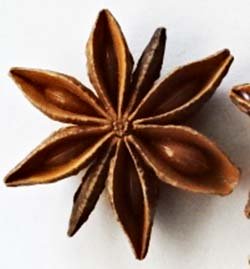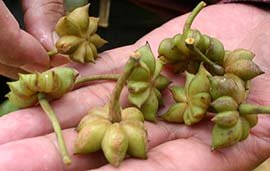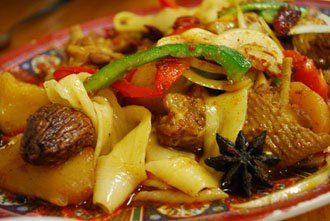Star anise Nutrition facts
Star anise is the star-shaped fruit of the spice plant native to the mountainous rain-forests of South Eastern China and Vietnam. Popular as ba jiao in mainland China, the spice has been part of the famous Chinese five spice powder.
Botanically, the spice is a member of the Magnoliaceae family. Scientific name: Illicium verum.
 |
| Star anise. Note rusty-brown, dried fruit pod. |
Star anise is an evergreen, medium-sized tree, reaching a height of about 30 feet. It grows well in humus-rich, well-drained, mildly acidic to neutral soils.
The tree bears fruits after 6-7 years of plantation, but then it has a productive life up to a hundred years. Yellow daffodil-like flowers appear from March to May which develop to yield fruits by October. Raw, immature fruits are green, and open out into a star shape upon reaching maturity.
Mature star-anise fruit pods are harvested just before they ripen completely. They feature star-shaped, reddish-brown pericarp consisting of 6-8 points (carpels) arranged in a whorl pattern. Each point (carpel) is 1.5 cm long, boat-shaped, and enclosing a single seed. Seeds are hard, amber-colored, ovoid, smooth, and shiny.
 |
| Raw, immature, green star anise fruits. Courtesy: fuzheado |
The seeds, as well as the husk, have a valued use as a condiment spice. Star anise features a delicately sweet taste and pleasant aromatic fragrance with a distinctive licorice flavor. Their special aroma comes from essential oil, anethole.
The star anise crop is grown at a commercial scale in Yunnan, Guizhou, and Guangxi provinces of China, and Lang Son province (Van Quan District) of Vietnam.
10 Incredible Health Benefits of Star Anise
The pericarp (outer coat) of star anise fruit accounts for the major portion of its volatile oils. Apart from essential oils, the spice holds several important antioxidants, minerals, and vitamins that play a vital role in disease prevention, health promotion, and wellness.
The primary essential volatile oil that gives the characteristic sweet, aromatic flavor to star anise is anethole. Anethole is an organic compound that is 13 times sweeter than sugar.
Research studies reported that anethole possesses antibacterial properties including both bacteriostatic and bactericidal action against Salmonella enterica and in vitro, inhibitory effects on gram-positive bacteria such as streptococcus.
Some of the other important chemical substances in ba jiao are methyl chervicol, anisaldehyde, pinene, peruviol (nerolidol), citrophen, cineol, safrole, etc.
Star anise oil obtained from the spice has been found applied in many Traditional Chinese Medicines (TCM) as carmintive, stomachic, antiseptic, antispasmodic, digestive, expectorant, stimulant and tonic.
In Traditional Chinese Medicines (TCM), Star anise nutrition is considered as Qi regulating and viewed as yang strengthening (warm) food item. It was found useful as a comforting spice item to counter harsh winter colds and flu episodes.
star anise has been reported to yield 3 to 7% shikimic acid. Shikimic acid is an important component of the medicine oseltemevir (Tamiflu) used for the treatment influenza virus.
The spice is an excellent source of many essential B-complex vitamins such as niacin, pyridoxine, pantothenic acid, and riboflavin.
The star spice is an excellent source of minerals like calcium, iron, phosphorus, potassium, manganese, zinc, and magnesium.
Further, the spice also holds some other valuable antioxidant vitamins such as vitamin C and vitamin A.
Processing
There are four methods of processing star anise: sun drying, blanching and sun drying, mechanical dehydration, and dehydrator drying.
For sun drying, freshly harvested unripe star anises are dried in piles in the drying field, with regular turning until completely dried.
Blanching and sun drying: Star anise pods are blanched in 90-100 degrees C water for 4-6 minutes with occasional stirring. When the color of the green fruits turns light yellow, remove them from the blanching water. Spread on the drying field and dry under the sun.
Mechanical drying: Heat up the dehydrator to 90-100 degrees C and put in the freshly harvested star anise fruits. Adjust the temperature to 50-60% and maintain the temperature for 7-8 hours to complete dehydration.
Dehydrator drying: This is the quick method. Here fresh star anise fruits are put into the boiler-generated steam baking chambers at 45-55 degrees C. The process can be completed in 24 h.
Selection and storage
Whole as well as ground star anise powder can be readily available in the Asian markets and specialty shops year-round. Choose whole dried pods instead of its ground form for purity and authenticity.
Classical star anise pods feature eight-pointed, rust-brown carpels, which emit a pleasant aroma when rubbed between index and thumb fingers. Oftentimes broken/split whole pods and displaced seeds found in the packs/containers are just fine.
Whole pods last for several months kept in an airtight container away from strong light and humidity. Buy them in small quantities so that they would last for 3-4 months to avoid loss of their flavor because of evaporation of essential oils. Ground, powdered spice should be kept inside airtight containers and used as early as possible since it loses its flavor rather quickly.
Medicinal uses of Star anise
Star anise and its oil found application in many traditional medicines, particularly in traditional Chinese medicine (TCM) for their unique health-promoting and disease-preventing roles.
Star anise extraction is an excellent remedy for cough, bronchitis, and viral flu.
Its infusion can be helpful in digestive disorders such as colicky stomach pain, nausea, flatulence, and indigestion.
In China and Taiwan, its individual carpels (points) are chewed as a mouth freshener.
The essential oil "anethole" (star anise comprises 70 - 90%) has been found to have an estrogenic effect. The decoction obtained from the seeds is often prescribed in nursing mothers to promote lactation.
Culinary uses
 |
| Star anise spiced chicken recipe. Courtesy: Alpha |
Star anise is a unique spice featured in Chinese cooking. It tastes like licorice or anise seed. The whole pods, ground powder, or oil are employed in savory cooking all over mainland China, Vietnam, Japan, India, and other South Asian regions.
Star anise is one of the chief ingredient in popular Chinese five spice mixture along with fennel seeds, cinnamon, sichuan peppercorns (Hua jiao) and cloves.
As a part of five spice powder or more often the whole star anise (ba jiao) alone is used in traditional Chinese tea eggs recipes.
Whole star anise added to flavor soups such as Vietnamese beef noodle soup (pho bo) and popular Chinese dishes such as hui beef stew.
Star anise well-known as "chakra phool" in India and Pakistan where it is employed as a featured item in garam masalas to flavor different kinds of vegetables and meat stews and curries and to marinate meat.
This aromatic spice is used as a flavoring base for soups, sauces, bread, muffins, cakes, biscuits and in various other confectionaries.
In a way similar to aniseed, star anise spice also used to flavor drinks include prenod, French pastis, Spanish ojen, etc.
In small quantities, it is also used as a flavoring agent in the preparation of spice tea all over China.
Safety profile
Star anise is safe when used in small quantities. Its volatile oils include certain neurotropic sesquiterpenoids, veranisatins A, B, and C. Veranisatins showed convulsion and lethal toxicity in experimental animals.
Star anise oil and tea should not be used in young children below 5 years of age and in pregnant women.
Japanese star anise (Illicium anisatum) is considered as toxic by many food regulatory authorities around the world. (Medical disclaimer).
≺≺ Back to Spices from Star anise. Visit here for an impressive list of healthy spices with complete illustrations of their nutrition facts and health benefits.
≺≺ Back to Home page.
Further reading:
World Afro Forestry center (Illicium verum).. pdf -(opens in new window)
Gernot-Katzer's spice pages. (Opens in new window)/p>